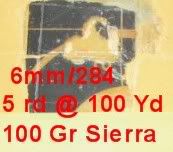The Accurate Reloading Forums
Rifling rate?
21 March 2008, 11:16
homebrewerRifling rate?
What is a good twist rate to use with a 6mm bullet in the 85- to 110-grain (approximate) weight range?
21 March 2008, 14:34
vapodog9"
///////////////////////////////////////////////////////////////////////////
"Socialism is a philosophy of failure, the creed of ignorance, and the gospel of envy, its inherent virtue is the equal sharing of misery."
Winston Churchill
22 March 2008, 19:04
britzI was lead to beleive that an 8 twist was necissary for heavy VLD bullets like the 107 grainers and so on w/ 6mm. Berger's website lists their reccomendations for rate of twist.
22 March 2008, 19:05
britzYou need a faster twist yet (7) to handle the newer 115 grain bullets.
28 March 2008, 20:05
homebrewerIt's going to be a target gun. I am a Sierra fanboy; that 107gr MatchKing has my name all over it. 1:7 or 1:8?
28 March 2008, 22:55
El DeguelloOnce again, required twist rate is determined by BULLET LENGTH not weight! For example, the original .244 Remington, with a 1/12" twist would stabilize 100-grain bullets just fine, IF they were the short round-nose type - but if you switched to spitzers, it would NOT do it. I have a 1/10" 6mm/284, and it does very well with all .243" bullets from the 85-grain Sierra HPBT up to and including the Speer 105-grain spitzer.

You can use the Greenhill formula to determine what twist you need fopr that 107-grain bullet. Measure the length of the bullet, and convert that measurement to calibers by dividing the o/a length by .243... Req Twist (in CALIBERS) = 150/bullet length in calibers. Very simple! Let us say, for illustration, that your bullet is 5 calibers long. 150/5=30. 30 X.243 = 7.29", so a 1/7" twist will do it, and then some. A 1/8" would be mnarginal, unless your bullet is shorter than 5 calibers.
"Bitte, trinks du nicht das Wasser. Dahin haben die Kuhen gesheissen."
13 April 2008, 07:21
1 lane bridgeOk, I'm trying here . . .
95 gr sierras i just got in are 1.2" in legnth. Now is where i dont under stand the equation. 1.2" / .243 equals 4.93?
Help! What am i reading wrong?
14 April 2008, 08:28
flacoAsk someone who knows.
I.e., your barrel maker.
Ask David Kiff.
People who do this every day, for money.
flaco
14 April 2008, 13:25
Bobby Tomekflaco wrote: "Ask someone who knows...People who do this every day, for money."
Just because someone does it for money doesn't mean they are the end-all for correct information.
As an example, there's one current custom maker who vehemently insists a 1:14 is the optimum twist for the 6mm-.223, 6mm TCU, etc. with bullets from 55-90 grains.
As someone who has poured thousands of rounds down the tubes of the little 6mm wildcats, I can tell you that's pure hogwash and that a 1:10 or even a 1:9 is needed. (Most of mine have been 1:10 for shooting flat-based 80s, but a 1:9 is an even better proposition for the likes of the 80 grain Ballistic Tip and similar projectiles.)
Within reason, one can't overstabilize a bullet, but you sure as heck can understablize one.
As to homebrewer's question, I'd opt for a 1:8 unless you planned on shooting the 115 grain VLD types, and then a 1:7 would be in order.
Bobby
Μολὼν λαβέ
The most important thing in life is not what we do but how and why we do it. - Nana Mouskouri
14 April 2008, 17:46
tom hollandI've never had a 6mm rifle build for both standard/VLD bullets but I agree with Flaco I'd be talking to the barrel manufactor as they get alot of feed back.
VFW
16 April 2008, 19:39
Red C.Here is a website that has a barrel twist calculator. It also takes into account the velocity of the bullet.
http://kwk.us/twist.html
Red C.
Everything I say is fully substantiated by my own opinion.
17 April 2008, 04:21
Big Bore Boar HunterThe actual rifling twist needed to stabilize a bullet is determined not by weight or length, but rather the ratio between the center of gravity and the center of pressure.
Weight and length affects these two, but aren't necessarily predictors.
Velocity also plays a part, the faster the bullet leaves the bore, the faster the bullet is spinning (in RPM) so a slower twist rate could be used. This is why .223 use 1-12 for 50 gr where as a .22-250 uses a 1-14.
As for Sierra bullets, all of their match kings give a reccomended twist rate. Make sure you are loading them for their intended velocity as well.
Now for the bonus question, why does a spinning bullet stabilize?
John
